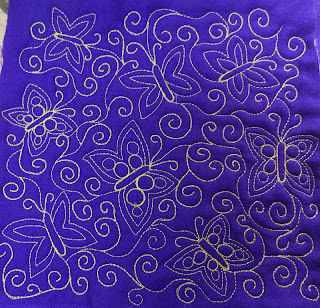There's 3 simple parts of the design, and you'll put them all together:
1. Kite
2. Tail
3. Loops
Let's see how you quilt it.
Kite:
1. Quilt a diamond. You'll end up back where you started.
2. Make a straight line to the tip of the kite. Sometimes it's tricky to end up at the right spot. It help me to keep my eyes on the point I'm aiming for, rather than watching the needle as I quilt.
Now you've finished the kite and the first part of the design is done! Next, we'll do the tail.
3. Make a curvy line away from the kite. Angle back toward the line to form a bow.
4. Form a triangle, returning to the point where you started the tail.
5. Now make the other side of the tail, with a mirror-image triangle. You'll finish back at the same point.
6. Add as many tails as you like. I usually make 1-3 tails per kite.
Then, when you are done with the tails, add some loops. Use the loops to travel as you need through the quilting space, until you are ready for the next kite.
7. Add a few more loops.
8. Now continue the design with kites and tails.
9. Here's a fun variation. Sometimes I think it's hard to quilt straight lines, and curves come more naturally. If that's the case for you, why fight it? Your kite can take inspiration from a manta-ray. Quilt each line as a curve, sloping in toward the center of the kite.
10. Whether you form the kite with straight lines, or with curves, remember to finish it by quilting a line through the center, ending at the bottom tip of the kite.
11. Finish up with tails and loops.
Have fun with the easy and free-flowing design! I'm linking up to FMQ Friday- check it out!
































